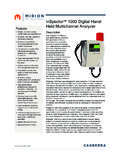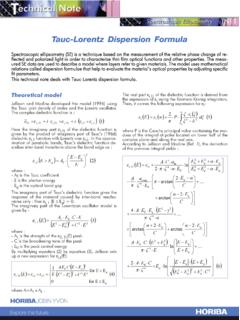Transcription of Gamma and X-Ray Detection Introduction - …
1 Gamma and X-Ray DetectionFigure Efficiency CalibrationDETECTOR OVERVIEWThe kinds of detectors commonly used can be categorized as: a. Gas-filled Detectors b. Scintillation Detectors c. Semiconductor DetectorsThe choice of a particular detector type for an application depends upon the X-Ray or Gamma energy range of interest and the application s resolution and efficiency requirements. Additional considerations include count rate performance, the suitability of the detector for timing experiments, and of course, EFFICIENCYThe efficiency of a detector is a measure of how many pulses occur for a given number of Gamma rays. Various kinds of efficiency definitions are in common use for Gamma ray detectors: a. Absolute Efficiency: The ratio of the number of counts produced by the detector to the number of Gamma rays emitted by the source (in all directions). b.
2 Intrinsic Efficiency: The ratio of the number of pulses produced by the detector to the number of Gamma rays striking the detector. c. Relative Efficiency: Efficiency of one detector relative to another; commonly that of a germanium detector relative to a 3 in. diameter by 3 in. long NaI crystal, each at 25 cm from a point source, and specified at MeV only. d. Full-Energy Peak (or Photopeak) Efficiency: The efficiency for producing full-energy peak pulses only, rather than a pulse of any size for the Gamma , to be useful, the detector must be capable of absorbing a large fraction of the Gamma ray energy. This is accomplished by using a detector of suitable size, or by choosing a detector material of suitable high Z. An example of a full-energy peak efficiency curve for a germanium detector is shown in Figure RESOLUTIONR esolution is a measure of the width (full width half max) of a single energy peak at a specific energy, either expressed in absolute keV (as with Germanium Detectors), or as a percentage of the energy at that point (Sodium Iodide Detectors).
3 Better (lower FWHM value) resolution enables the system to more clearly separate the peaks within a spectrum. Figure shows two spectra collected from the same source, one using a sodium iodide (NaI(TI)) detector and one using germanium (HPGe). Even though this is a rather simple spectrum, the peaks presented by the sodium iodide detector are overlapping to some degree, while those from the germanium detector are clearly separated. In a complex spectrum, with peaks numbering in the hundreds, the use of a germanium detector becomes mandatory for DETECTORSA gas-filled detector is basically a metal chamber filled with gas and containing a positively biased anode wire. A photon passing through the gas produces free electrons and positive ions. The electrons are attracted to the anode, producing an electric low anode voltages, the electrons may recombine with the ions.
4 Recombination may also occur for a high density of ions. At a sufficiently high voltage nearly all electrons are collected, and the detector is known as an ionization chamber. At higher voltages the electrons are accelerated toward the anode at energies high enough to ionize other atoms, thus creating a larger number of electrons. This detector is known as a proportional counter. At higher voltages the electron multiplication is even greater, and the number of electrons collected is independent of the initial ionization. This detector is the Geiger-Mueller counter, in which the large output pulse is the same for all photons. At still higher voltages continuous discharge different voltage regions are indicated schematically in Figure The actual voltages can vary widely from one detector to the next, depending upon the detector geometry and the gas type and CHAMBERThe very low signal output for the ionization chamber makes this detector difficult to use for detecting individual Gamma rays.
5 It finds use in high radiation fluxes in which the total current produced can be very large. Many radiation monitoring instruments use ionization chambers. Absolute ionization measurements can be made, using an electrometer for recording the COUNTERP roportional counters are frequently used for X-Ray measurements where moderate energy resolution is required. A spectrum of 57Co is shown in Figure in which keV Gamma rays are well-separated from the keV X rays from counters can be purchased in different sizes and shapes, ranging from cylindrical with end or side windows to pancake flat cylinders. They may be sealed detectors or operate with gas flow, and may have thin beryllium windows or be windowless. A detector is typically specified in terms of its physical size, effective window size and gas path length, operating voltage range and resolution for the keV X ray from a 55Fe source (Mn X ray).
6 Typical resolutions are about 16 to 20% full-width at half maximum (FWHM).03 / 2014 Radiation Safety. Amplified. of Mirion TechnologiesOperating voltages depend upon the fill gas as well as the geometry. For X rays, noble gases are often used, with xenon, krypton, neon and argon common choices. Xenon and krypton are selected for higher energy X rays or to get higher efficiencies, while neon is selected when it is desired to detect low energy X rays in the presence of unwanted higher energy X rays. Sometimes gas mixtures are used, such as P-10 gas, which is a mixture of 90% argon and 10% methane. Gas pressures are typically one atmosphere. The 2006 preamplifier available for proportional counters is shown in Figure COUNTERThe Geiger-Mueller counter produces a large voltage pulse that is easily counted without further amplification. No energy measurements are possible since the output pulse height is independent of initial ionization.
7 Geiger-Mueller counters are available in a wide variety of sizes, generally with a thin mica window. The operating voltage is in the plateau region (see Figure ), which can be relatively flat over a range of bias voltage. The plateau is determined by measuring the counting rate as a function of the anode Gas Detector Output vs. Anode VoltageThe discharge produced by an ionization must be quenched in order for the detector to be returned to a neutral ionization state for the next pulse. This is accomplished by using a fill gas that contains a small amount of halogen in addition to a noble gas. The voltage drop across a large resistor between the anode and bias supply will also serve to quench the discharge since the operating voltage will be reduced below the Geiger-Mueller counter is inactive or dead after each pulse until the quenching is complete. This dead time can be hundreds of microseconds long, which limits the counter to low count rate Proportional Counter and PreamplifierSCINTILLATION DETECTORSA Gamma ray interacting with a scintillator produces a pulse of light, which is converted to an electric pulse by a photomultiplier tube.
8 The photomultiplier consists of a photocathode, a focusing electrode and 10 or more dynodes that multiply the number of electrons striking them several times each. The anode and dynodes are biased by a chain of resistors typically located in a plug-on tube base assembly. Complete assemblies including scintillator and photomultiplier tube are commercially available from properties of scintillation material required for good detectors are transparency, availability in large size, and large light output proportional to Gamma ray energy. Relatively few materials have good properties for detectors. Thallium activated NaI and CsI crystals are commonly used, as well as a wide variety of plastics. LaBr3 (Ce) crystals are a newer type of scintillation detector material offering better resolution, but otherwise, similar characteristics to NaI detector crystals. NaI is still the dominant material for Gamma Figure 57Co Spectrum from CounterSEMICONDUCTOR DETECTORSA semiconductor is a material that can act as an insulator or as a conductor.
9 In electronics the term solid state is often used interchangeably with semiconductor, but in the detector field the term can obviously be applied to solid scintillators. Therefore, semiconductor is the preferred term for those detectors which are fabricated from either elemental or compound single crystal materials having a band gap in the range of approximately 1 to 5 eV. The group IV elements silicon and germanium are by far the most widely-used semiconductors, although some compound semiconductor materials are finding use in special applications as development work on them shows some of the key characteristics of various semiconductors as detector materials:Table Element vs. Band GapMaterialZBand Gap (eV)Energy/e-hpair(eV) detectors have a p-i-n diode structure in which the intrinsic (i) region is created by depletion of charge carriers when a reverse bias is applied across the diode.
10 When photons interact within the depletion region, charge carriers (holes and electrons) are freed and are swept to their respective collecting electrode by the electric field. The resultant charge is integrated by a charge sensitive preamplifier and converted to a voltage pulse with an amplitude proportional to the original photon the depletion depth is inversely proportional to net electrical impurity concentration, and since counting efficiency is also dependent on the purity of the material, large volumes of very pure material are needed to ensure high counting efficiency for high energy because it provides good Gamma ray resolution and is economical. However, plastics have much faster pulse light decay and find use in timing applications, even though they often offer little or no energy (Tl) SCINTILLATION DETECTORSThe high Z of iodine in NaI gives good efficiency for Gamma ray Detection .









